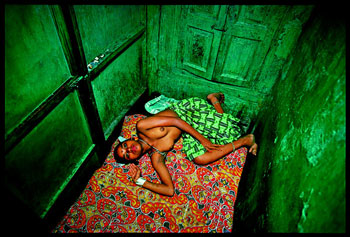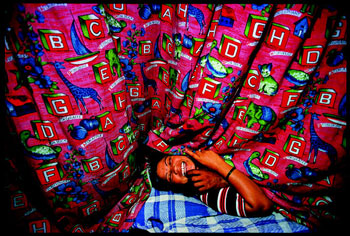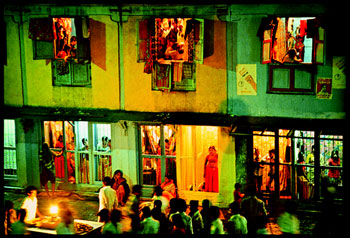I don't know if you've spent much time in your life pondering the eternal question of what happens when an irresistible force meets an immovable object. The closest I've ever come to an answer is Mary Ellen Mark, although in her case the question should be slightly revised to "What happens when an irresistible force meets an immovable subject?" The answer is that the subject generally moves, and becomes a willing accomplice in the production of powerful photography. In a career that spans four decades, and is nowhere near over yet, she has brought us image after image that not only embed themselves into our memory but in doing so help us define ourselves as the cohabitants of a small planet. As a picture editor who has had the privilege of assigning her stories that have produced some of her classic works I have witnessed the focused intensity that she brings to her professional life, and which tolerates no compromise.
It seems that this level of determination and commitment is something that is not acquired but imprinted into a photographer's DNA from birth. Proof of this can be found in the new reprint of her book Falkland Road: Prostitutes of Bombay that Steidl will publish in March this year. The photographs in this book were shot between October 1978 and January 1979 on an impoverished street in Bombay that houses numerous brothels where cheap prostitutes work and live. It was a street that fascinated her on her first visit to India in the late Sixties, and one to which she vowed to return. A decade was to pass before she would go back in late 1978 with an assignment from Geo in her pocket.
Getting the job proved to be easier than completing it for this was an area where few non-Indians went, particularly women and especially women with cameras. The street's inhabitants were hostile, even to the point of throwing things at her, but she kept coming back. She also did the unimaginable and stepped inside one of the brothels, which caused extreme consternation in the form of screaming and yelling. But unbeknownst to her she was being watched by somebody who at the time was one of the most powerful madams on the street, a woman called Saroja. A few days later she waved to Mary Ellen from her second-floor window and invited her in for tea. The photographer was now inside the brothels and known as a friend of Saroja. From this point on all doors would open for her. Mary Ellen knows from experience that on any project there is a point of access that has to be arrived at before the serious work can begin, and this was it.
 |
Twelve-year-old Lata lying in bed Mary Ellen Mark/Marianne Boesky Gallery |
She considers rejection to be part of a photographer's job, at least if you want to photograph people. "Buildings and plants and trees won't reject you, but people can and you have to be prepared for that, and it will happen. You have to learn to accept it and try to turn it around." She turned it around though shooting every day and night for a period of two months, achieving a very high level of intimacy with her photographs of the girls, and girls they were, the youngest being twelve. When she explains her fascination with Falkland Road and its inhabitants she uses words such as purity and innocence, terms not usually associated with prostitutes, but the photographs in the book do in fact radiate a kind of damaged simplicity. These girls do not sell their bodies to support a drug habit or as an act of rebellion against society. They do it to escape the extreme poverty into which they were born, sometimes being sold to the madams by their mothers. That life as a five-rupee hooker should be the better alternative may be shocking to us, but for them it was the sad reality. They at least had a place to sleep, nice clothes and makeup. Mary Ellen comments, "I don't think any of them loved doing this but I think for them it was better than being beggars or being cast out of your house because you're a girl and your family doesn't have the dowry money for you."
 |
Mary Ellen Mark would hear voices from behind the curtains; once a customer saying, "My glasses, my glasses, where are my glasses?" and a thirteen-year-old prostitute saying, "Come on now, behave, be proper." Mary Ellen Mark/Marianne Boesky Gallery |
They came from a simple society, which didn't radically change when they entered the brothels. During the day they slept, cooked, played with the children, and often fought among themselves, the kind of daily activities typical of the rural villages from which many of them came. It was at night that their lives diverged dramatically from their former existence. The workspace in Saroja's house was two beds with curtains drawn around them, while a third acted as a waiting area for the girls and their customers if the others were occupied. The curtains that minimally protected their privacy during the sex act were patterned with the alphabet, giving a kindergarten-like tone to the proceedings. At the end of the evening each girl's take was divided equally between her and the madam, who was undisputedly the boss.
Mary Ellen was drawn to Falkland Road because of the absence of pimps at the time that she worked there. It was a matriarchal society run by the madams; the only men we see in the photographs are customers. Mark says that the prostitutes "had to obey the madam and no questions asked, but there were some madams that were very kind and nurturing and loving to the girls, a bit like a mother, one that they didn't have because their own mothers sold them."
There were also street prostitutes on Falkland Road, women who worked independently without the benefits of or interference from a madam. They lived and solicited on the streets, renting a room from one of the madams as needed. Their headquarters was the Olympia Café, a bustling establishment with mirrored walls, where only tea and sodas were served -- no alcohol. Here they would hang out, drink tea, smoke and meet customers. Understandably the madams didn't approve of the street women. One is quoted in the book as saying, "I would never let a street girl live in my house. They are too independent. They steal, and they often have boyfriends who are pickpockets or thieves. I wouldn't let my girls associate with these kinds of girls."
 |
Falkland Road at night. Mary Ellen Mark/Marianne Boesky Gallery |
While it was one thing to be able to get the trust of the prostitutes that Mary Ellen saw, and who saw her day in and day out, it is astonishing that she also managed to elicit the cooperation of the customers. Can you imagine what your reaction would be if you turned up for a little paid sex to find a determined young western woman with a camera in the same room as you and the girl you've just hired? Remarkably enough they didn't seem to mind, which the photographer puts down to the fact that the customers were as innocent as the prostitutes. "I think they were very surprised when they saw me, but they weren't like forceful businessmen, so terrified and afraid that their wives would find out. A couple of times I did see men in Arab robes, and I wanted to get their picture but they always seemed to avoid me. A customer from Saudi Arabia was a big deal because they were rich."
On her last day with Saroja and her girls, just before she was to return to New York, Mary Ellen even got some advice from one of the clients. The madam gave the photographer a party, which consisted of fearsomely hot chicken biryani, sodas and cake. However, since the event was held in the same room as the beds, and since business didn't stop for a party, girls would pop behind the curtains with a customer, and then rejoin the celebration. After one such incident the customer asked what was happening. "We were about to leave and we were all crying, and it was sad, tears and hugs, and this guy came out and said, 'What's going on?' I had a translator with me and the translator explained to him that I was leaving and I was so sad and going back to New York, and he said, 'Well, what's the big deal? Go back to New York, find some girls, bring them back to Falkland Road and open up a brothel.'" It was a career move than she declined to make.
She did, however, return twice to Falkland Road. Once, about a year after shooting she went back with books for Saroja, but she was not there. She had fallen on even harder times, and was now working in a poorer district that was comprised almost entirely of tents, like a camp. When Mary Ellen finally found her she looked tired, thin and frail, and was possibly suffering from AIDS, which was just beginning its horrific onslaught. The photographer returned a second time about 15 years ago, but Saroja was nowhere to be found. Falkland Road had also changed. There seemed to be much greater drug usage, and many more pimps. She went into the Olympia Café, but nobody remembered her or knew any of the names that she inquired about. The characters that she photographed may be dead, in jail, or simply moved on, but they still live for us in the pages of this book.
In many ways these photographs are dissimilar to the style that she evolved since then. For one thing they are in color (Mary Ellen says she doesn't like color because it's too colorful) and they are much more traditionally documentary than the work for which she has become famous. The remarkable thing is that they are still as relevant to us today as they were when the first edition of the book appeared 25 years ago, maybe more so.
We seem to be living in a particularly uncharitable age, where people who don't look like us, live like us or think like us are too often dismissed and despised. What better time, then, to be reminded that the poorest of earth's poor, victims of circumstances beyond their control, have dignity and humanity, live, laugh and cry? The conditions under which they exist and the measures they take to survive may be different to ours but the intimacy they share with us through a photographer's skill is a powerful connection. Like all great documentarians Mary Ellen is non-judgmental. Think of some of her eminent predecessors such as W. Eugene Smith, Margaret Bourke-White, or Lewis Hine. What they all have in common is an intense empathy for their subjects, and that is what makes their work not only compelling, but also timeless. It is a tribute to the staying power of both the photographer and the photographs that 27 years after they were taken we can still feel connected to people we will never know and lives we will never experience. This is truly the heart of the power of photography.
On the flaps of the dust jacket to Falkland Road there is an outline of the many awards and honors Mary Ellen has received during her distinguished career, including five honorary doctorates. When I asked her if she had any unrealized ambitions she said, "To keep on working." Even for someone of her stature this is not easy, and each year, as our culture becomes more steeped in fantasy and mindless entertainment, the market for reality, especially the reality of distant people, becomes less and less. But if there is one thing that I have learned from people like her it is the power of persistence. Given time the relentless pursuit of your goals will shift the most immovable object.
Pre-order Falkland Road at Amazon.

